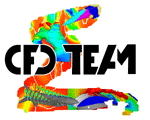WORK PROGRAM
The objective of this proposal is to develop an integrated framework in which recent progress in HPC (especially in the field of LES but also in TA codes methodology) will be used to improve methods for CI prediction and control. Brute force LES (Large Eddy Simulation) and TA (thermoacoustic) codes are the two basic elements of the project but combustion instability theory (Culick 2006, Poinsot and Veynante 2005, Nicoud and Poinsot 2005) is the third one. Theory remains necessary at all stages of the present proposal. In particular, INTECOCIS will focus on three aspects:
Part I: Introducing HPC and LES into combustion instability studies.
This will require moving from numerical approaches developed by small teams to an ambitious effort incorporating recent methods for LES and TA codes developed for massively parallel computers. An additional dimension of INTECOCIS is to make these tools available to the scientific community: IMFT and CERFACS are already working with many other actors of the combustion community worldwide and distributing their codes. The LES code AVBP is one example of such an effort where a code developed by CERFACS and IFP-EN has been distributed worldwide and is used today by more than 150 scientists, in laboratories and industry research centers (cerfacs.fr/4-26334-The-AVBP-code.php). Organizing the combustion instability community around existing high-level software tools is a priority: Cambridge (around a low-order code called LOTAN by Pr A. Dowling) or TU Munich (with the tax library (Leandro et al 2010) by Pr Polifke) are good examples of coordinated efforts in the field of CI but without the HPC component: the present proposal will follow a similar path but will focus on LES and TA codes using HPC.
Part II: Introducing Uncertainty Quantification (UQ) into LES and TA codes.
In most cases, the outcome of CI studies is a discontinuous function: either the combustor is stable or it is not. Making decisions based on this result requires the knowledge of the precision with which it is obtained. Since CIs are known to be very sensitive to multiple physical parameters (flow regime, manufacturing tolerances, fuel changes…) and since the codes (brute force LES as well as TA codes) used to predict combustion instabilities are also sensitive to many hidden parameters (number of mesh points, accuracy of numerical methods, boundary conditions…), introducing UQ has become an important issue that is virtually untouched today (see recent IMFT work by Duchaine et al (2010)) and that will be an essential part of the present project. Shape optimization using simulation to mitigate CIs will be a logical addition to the UQ task: being able to predict the effects of geometrical changes or of parameter variations (flow rates, compositions) directly allows searching for the most stable configurations using very similar tools.
Part III: Validation in academic burners and application to gas turbine combustion.
Such a large-scale numerical effort cannot be successful without experimental validation. These validations are performed at various levels: mean flows (cold and reacting), FTFs, stability maps. IMFT develops its own (small-scale) experiments in the field of combustion instability and also has a long history of cooperation with most combustion instability groups in the world (Cambridge Univ, Ecole Centrale Paris, TU Munich, Un. Twente, Stanford, Georgia Tech) through many common projects and papers. Upon completion of these academic validation exercises, the last two years of the project will focus on industrial applications with European companies that have been in contact with IMFT and CERFACS for the last ten years and are facing CIs: Turbomeca, Snecma, Alstom, Siemens, Ansaldo are a few examples of European companies with a clear need for an ambitious project to simulate CIs and to control them. These companies will be contacted at the beginning of INTECOCIS and invited to define challenging industry test cases to be used as ultimate proofs of efficiency for INTECOCIS tools. Of course, the validation of INTECOCIS codes will be restricted to “open” configurations (for which results can be published).


